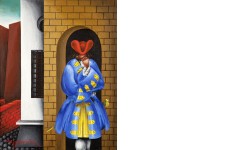Ελαιογραφία 249Μικτή Τεχνική 357Σχέδιο 293Αυγοτέμπερα 77Τέμπερα 132Ακρυλικά 1Παστέλ 1Gouache 2Υδατογραφία 34Χαρακτική 1
Ειδικές Πληροφορίες για τον Καλλιτέχνη
TITΛΟΣ ΕΡΓΟΥCazanova
ΔΙΑΣΤΑΣΕΙΣ ΕΡΓΟΥΎψος : 41
Πλάτος : 33
ΥΛΙΚΟ ΚΑΤΑΣΚΕΥΗΣΕλαιογραφία (Λάδι σε καμβά)
ΥΠΟΓΡΑΦΗ ΚΑΛΛΙΤΕΧΝΗΚάτω Αριστερά
ΧΡΟΝΟΛΟΓΗΣΗ01-01-1968
ΕΛΕΓΧΟΣ ΓΝΗΣΙΟΤΗΤΑΣΔεν έχει ελεγχθεί

Provenance
Acquired from the artist's family by the present owner.
Inspired by the romance of a bygone era, Engonopoulos's Casanova introduces the viewer to an enigmatic system of poetic metaphor which alludes to collective cultural symbols. The image of the lover appears in a number of the artist's canvases,1 including Lady Chatterley's lover (1951), Lovers (1967), On the ship decks (1966), in which Giacomo Casanova is portrayed in stylish western garb, and Casanova (1968), wherein he wears a marvellous, brilliantly coloured costume - the same one Hector wears in his Hector and Andromache, 1969. Engonopoulos, who had designed colourful costumes for many theatrical performances, had been involved with fashion from an early age, publishing the magazine La Mode Grecque in French and German. However, there are hardly any references to contemporary fashion in his work, as he deliberately ignored the fashion trends of his era, consistently alluding to otherly times, to collective symbols from various moments and junctures in history.2
From the mid-1960s on, the artist showed a predilection for simple compositions with just a few figures3 painted with glowing intensity. His enamel-like reds, blues and greens, applied side by side on the canvas without tonal gradations, invite the viewer to a festive ritual of pure colour. For Engonopoulos each colour had its own value, its own voice, much the same as in Byzantine art, which he always considered the art form Greeks most closely relate to.4 While El Greco rendered the compositional and colour scheme of Byzantine art in a western manner, Engonopoulos filtered it though surrealism, becoming a cantor in his artistic pew chanting the Byzantine music of colours5 and praising the beauty of the human form.
1. See D. Menti, Faces and Masks [in Greek], Gutenberg editions, Athens 2007, p. 163.
2. See N. Andrikopoulou, Tracing the footsteps of Nikos Engonopoulos [in Greek], Potamos editions, Athens 2003, p. 100.
3. His last multi-figure work dates back to 1963. See K. Perpinioti-Agazir, Nikos Engonopoulos, Son Univers Pictural, exh. cat. and catalogue raisonée, Benaki Museum, Athens 2007, p. 106.
4. See Epitheorisi Technis magazine, March 1963, pp. 193-197 and E. Engonopoulou, "Freedom and Discipline" in Nikos Engonopoulos, The Painter and the Poet, p. 23.
5. See A. Kastalliotis, "Nikos Engonopoulos" [in Greek], Synchroni Skepsi journal, no.4, February 1977, reprinted in Nikos Engonopoulos, exhibition catalogue, National Gallery-Alexandros Soutzos Museum, Athens 1983, p. 29.